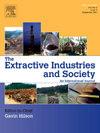性别与采矿:评估关键矿产供应链中女企业家的前景
IF 4.3
2区 社会学
Q2 ENVIRONMENTAL STUDIES
Extractive Industries and Society-An International Journal
Pub Date : 2025-09-01
DOI:10.1016/j.exis.2025.101753
引用次数: 0
摘要
采矿业的飞地性对关键矿产供应链内的女企业家有什么影响?本文试图通过该行业的飞地特征来审视它,从而重新构建采矿中的性别考虑。具体来说,它探讨了在关键的矿物部门经营的当地女企业主所遇到的挑战和机会。根据加纳的实地研究,本文表明,在向关键矿物过渡的过程中,参与采矿活动的妇女的不同身份对于有效的环境、社会和治理(ESG)实践至关重要。尽管妇女在采矿方面具有历史意义,但社会文化因素继续影响她们的参与。长期以来,已作出各种努力,通过研究进展和政策改革使妇女有意义地参与采矿。然而,这些问题主要集中在采矿工人身上,而忽视了更广泛的供应链。这种重点掩盖了妇女在大规模采矿作业中所面临的复杂性,限制了解决该部门内性别不平等问题的办法。调查结果表明,在关键的矿产供应链中,飞地性给当地女企业家带来了独特的障碍,阻碍了实现包容性和可持续发展的前景。然而,只要对飞地性有充分的理解,机会就可能存在。本文章由计算机程序翻译,如有差异,请以英文原文为准。
Gender and mining: Assessing the landscape for women entrepreneurs in the critical minerals supply chain
What are the implications of enclavity in mining for women entrepreneurs within the critical minerals supply chain? This article seeks to reframe gender considerations in mining by examining it through the lens of the industry's enclave characteristic. Specifically, it explores the challenges and opportunities encountered by local women business owners operating in the critical minerals sector. Drawing on field research from Ghana, the article demonstrates that the diverse identities of women involved in mining activities are crucial for effective Environmental, Social, and Governance (ESG) practices during the transition to critical minerals. Despite the historical significance of women in mining, sociocultural factors continue to shape their participation. Over time, various efforts have been made to meaningfully engage women in mining through research advancements and policy reforms. However, these have primarily centred on the mining workforce, overlooking the broader supply chain. This focus has obscured the complexities faced by women in large-scale mining operations, limiting approaches to addressing gender disparities within the sector. The findings suggest that enclavity presents unique obstacles for local women entrepreneurs in the critical minerals supply chain, impeding the prospects of achieving inclusive and sustained development. Yet, opportunities may exist, provided there is a robust understanding of enclavity.
求助全文
通过发布文献求助,成功后即可免费获取论文全文。
去求助
来源期刊

Extractive Industries and Society-An International Journal
ENVIRONMENTAL STUDIES-
CiteScore
6.60
自引率
19.40%
发文量
135
 求助内容:
求助内容: 应助结果提醒方式:
应助结果提醒方式:


